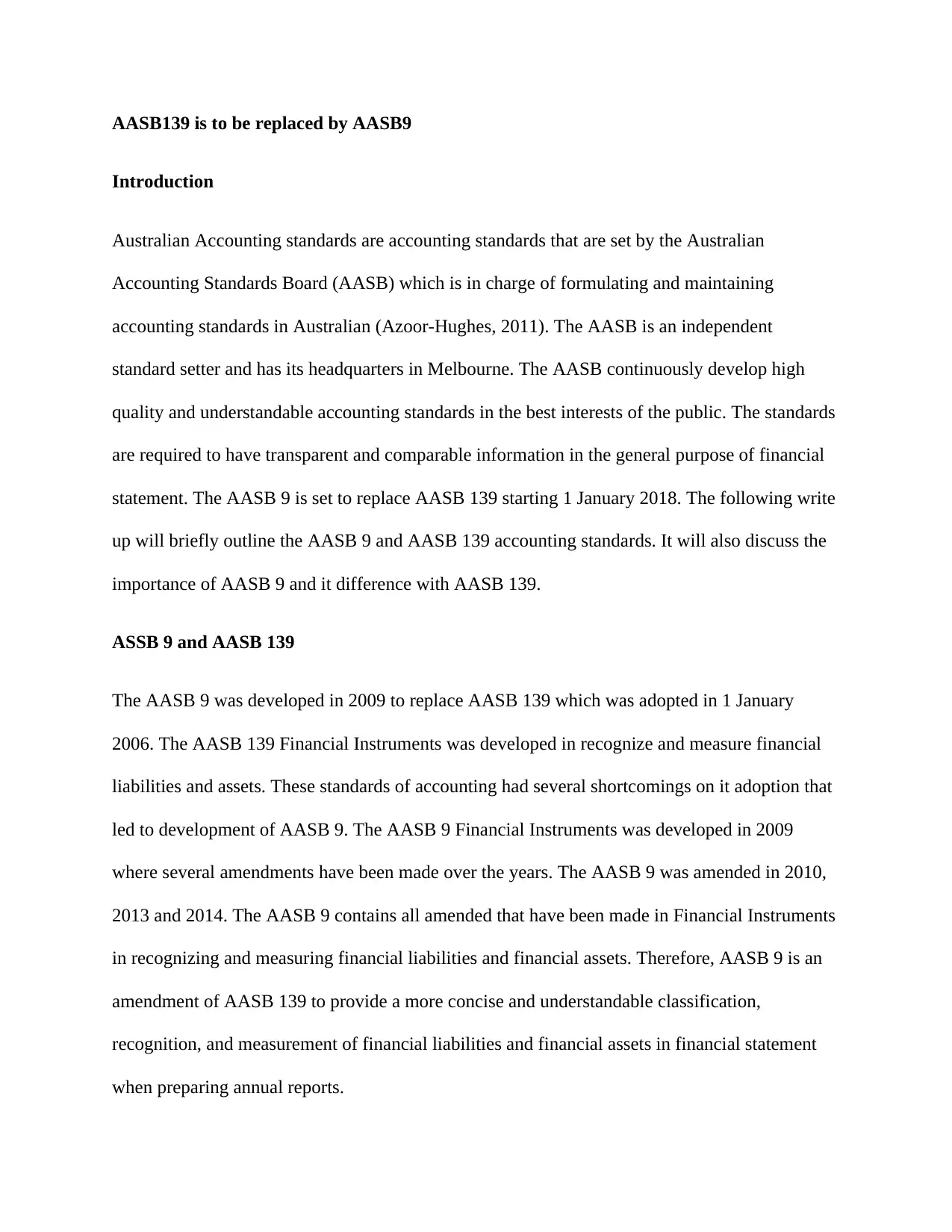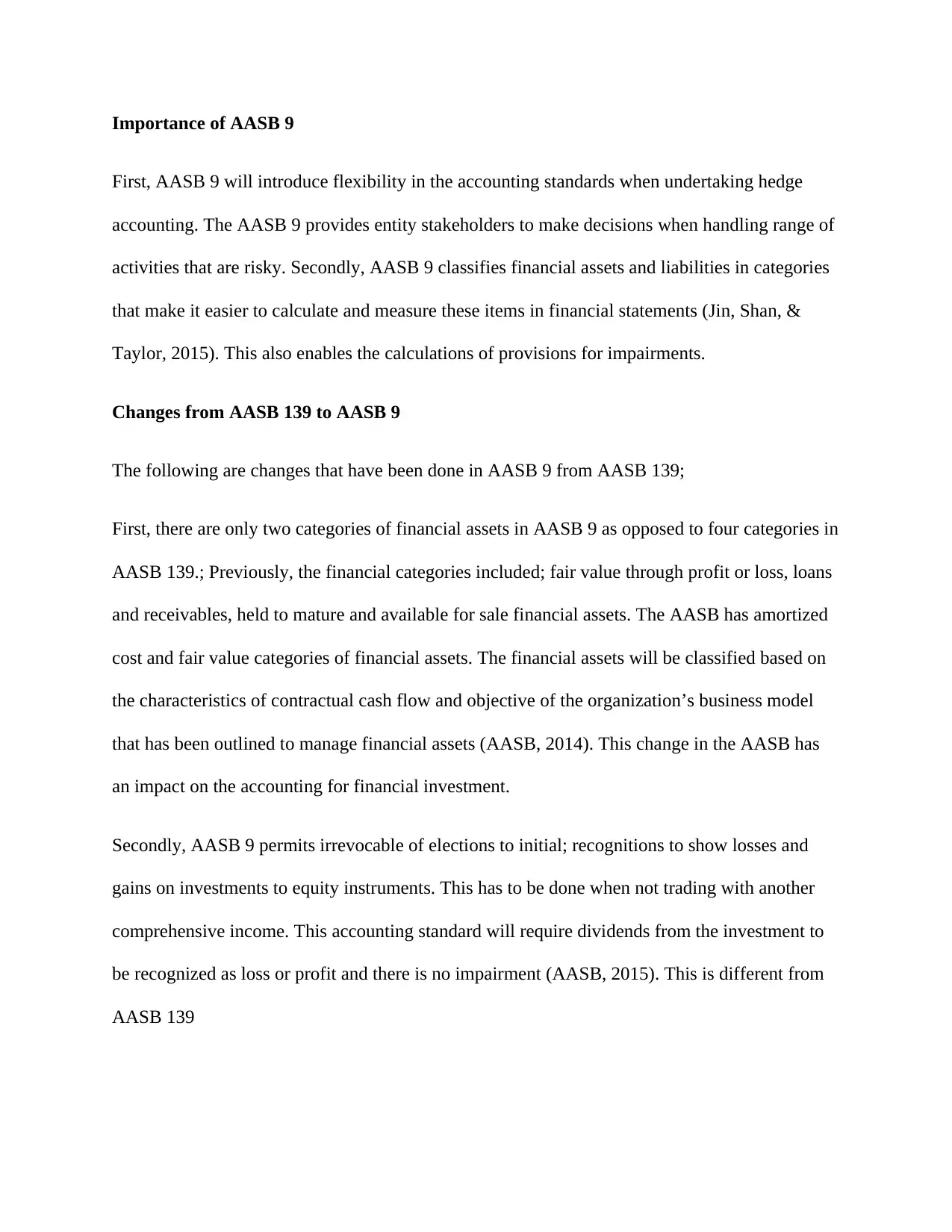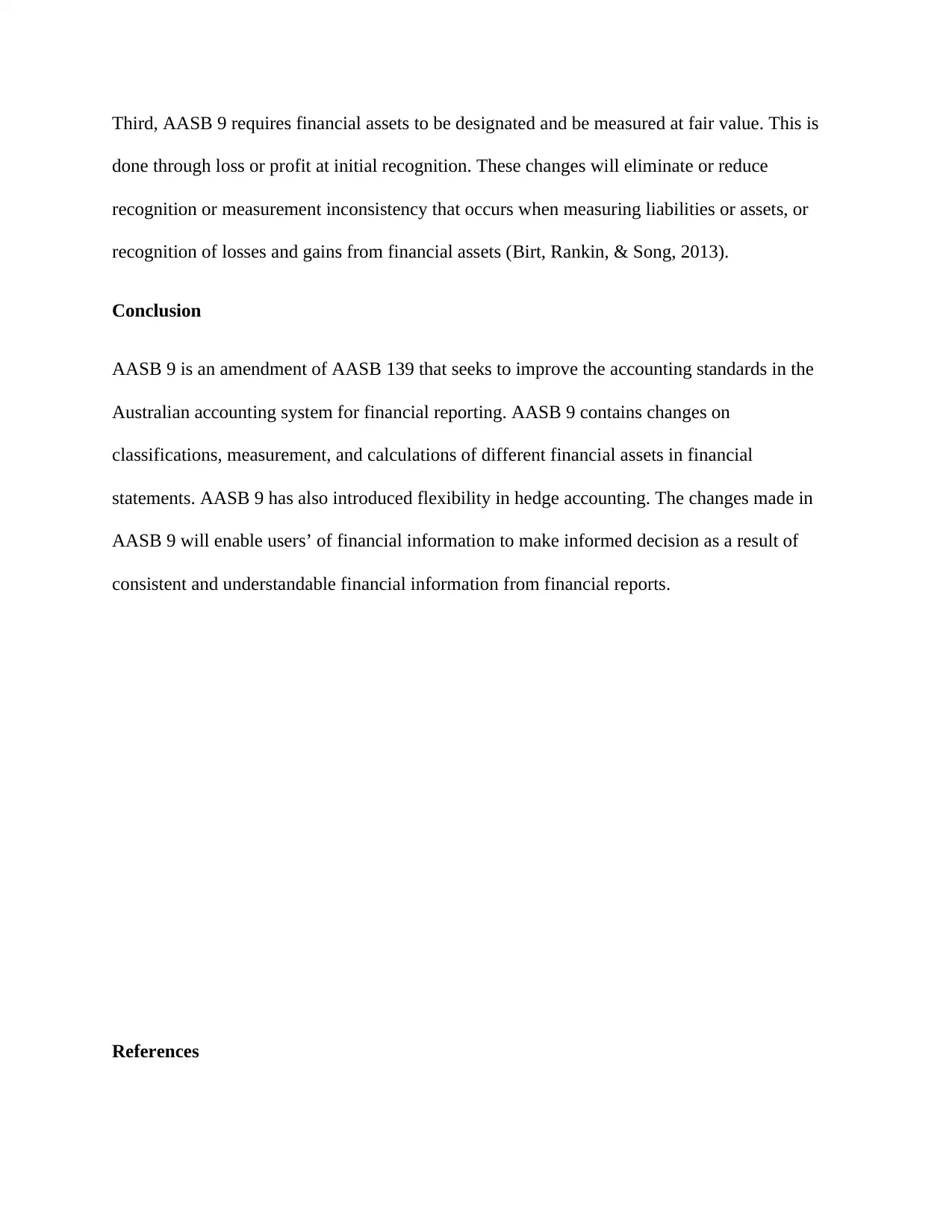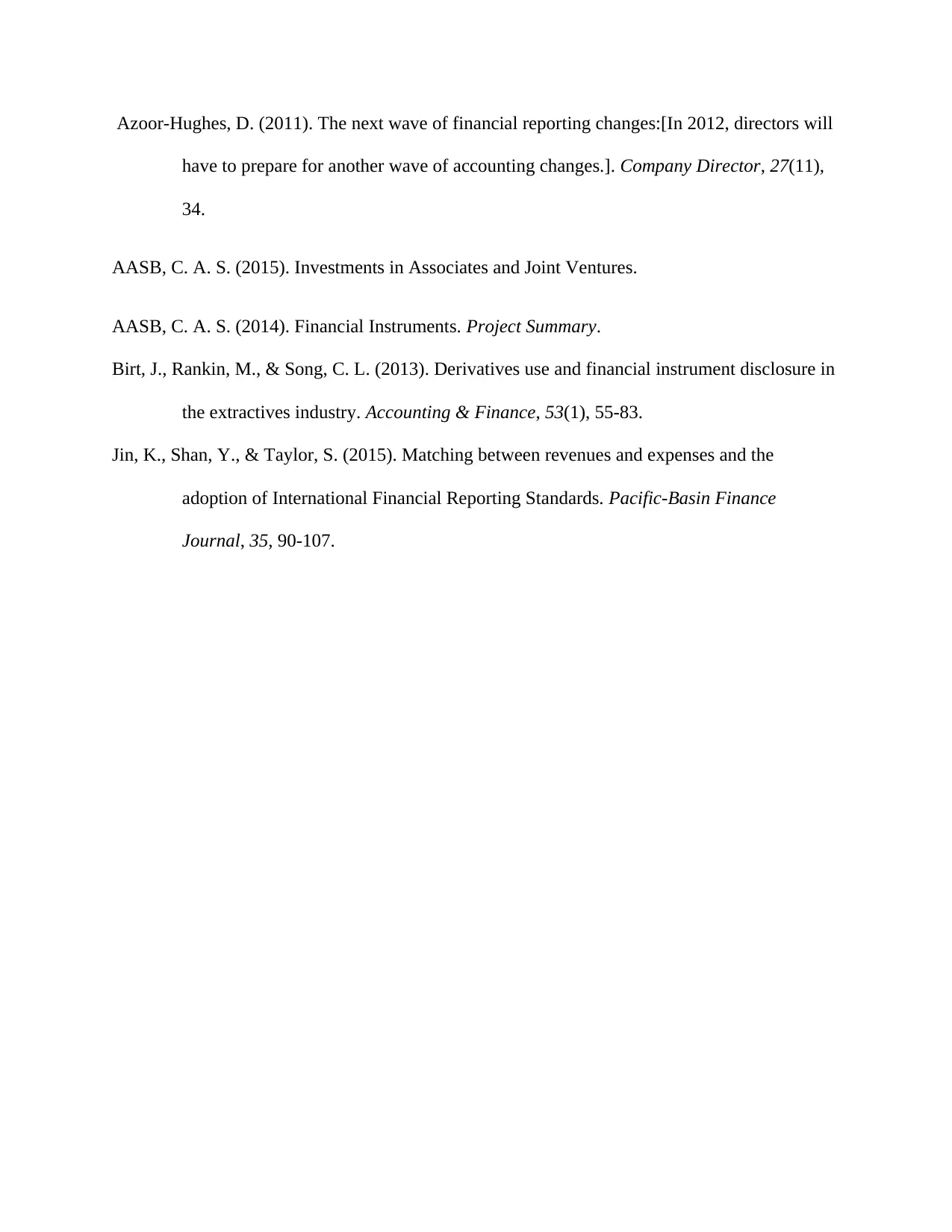AASB 9 vs AASB 139 Analysis
VerifiedAdded on 2020/03/16
|5
|885
|61
Report
AI Summary
This report discusses the transition from AASB 139 to AASB 9, highlighting the key changes in accounting standards for financial instruments. It outlines the importance of AASB 9, its flexibility in hedge accounting, and the simplification of financial asset classifications. The report also emphasizes how these changes enhance the clarity and consistency of financial reporting, enabling stakeholders to make informed decisions.

UNIT:
NAME:
DATE:
NAME:
DATE:
Paraphrase This Document
Need a fresh take? Get an instant paraphrase of this document with our AI Paraphraser

AASB139 is to be replaced by AASB9
Introduction
Australian Accounting standards are accounting standards that are set by the Australian
Accounting Standards Board (AASB) which is in charge of formulating and maintaining
accounting standards in Australian (Azoor-Hughes, 2011). The AASB is an independent
standard setter and has its headquarters in Melbourne. The AASB continuously develop high
quality and understandable accounting standards in the best interests of the public. The standards
are required to have transparent and comparable information in the general purpose of financial
statement. The AASB 9 is set to replace AASB 139 starting 1 January 2018. The following write
up will briefly outline the AASB 9 and AASB 139 accounting standards. It will also discuss the
importance of AASB 9 and it difference with AASB 139.
ASSB 9 and AASB 139
The AASB 9 was developed in 2009 to replace AASB 139 which was adopted in 1 January
2006. The AASB 139 Financial Instruments was developed in recognize and measure financial
liabilities and assets. These standards of accounting had several shortcomings on it adoption that
led to development of AASB 9. The AASB 9 Financial Instruments was developed in 2009
where several amendments have been made over the years. The AASB 9 was amended in 2010,
2013 and 2014. The AASB 9 contains all amended that have been made in Financial Instruments
in recognizing and measuring financial liabilities and financial assets. Therefore, AASB 9 is an
amendment of AASB 139 to provide a more concise and understandable classification,
recognition, and measurement of financial liabilities and financial assets in financial statement
when preparing annual reports.
Introduction
Australian Accounting standards are accounting standards that are set by the Australian
Accounting Standards Board (AASB) which is in charge of formulating and maintaining
accounting standards in Australian (Azoor-Hughes, 2011). The AASB is an independent
standard setter and has its headquarters in Melbourne. The AASB continuously develop high
quality and understandable accounting standards in the best interests of the public. The standards
are required to have transparent and comparable information in the general purpose of financial
statement. The AASB 9 is set to replace AASB 139 starting 1 January 2018. The following write
up will briefly outline the AASB 9 and AASB 139 accounting standards. It will also discuss the
importance of AASB 9 and it difference with AASB 139.
ASSB 9 and AASB 139
The AASB 9 was developed in 2009 to replace AASB 139 which was adopted in 1 January
2006. The AASB 139 Financial Instruments was developed in recognize and measure financial
liabilities and assets. These standards of accounting had several shortcomings on it adoption that
led to development of AASB 9. The AASB 9 Financial Instruments was developed in 2009
where several amendments have been made over the years. The AASB 9 was amended in 2010,
2013 and 2014. The AASB 9 contains all amended that have been made in Financial Instruments
in recognizing and measuring financial liabilities and financial assets. Therefore, AASB 9 is an
amendment of AASB 139 to provide a more concise and understandable classification,
recognition, and measurement of financial liabilities and financial assets in financial statement
when preparing annual reports.

Importance of AASB 9
First, AASB 9 will introduce flexibility in the accounting standards when undertaking hedge
accounting. The AASB 9 provides entity stakeholders to make decisions when handling range of
activities that are risky. Secondly, AASB 9 classifies financial assets and liabilities in categories
that make it easier to calculate and measure these items in financial statements (Jin, Shan, &
Taylor, 2015). This also enables the calculations of provisions for impairments.
Changes from AASB 139 to AASB 9
The following are changes that have been done in AASB 9 from AASB 139;
First, there are only two categories of financial assets in AASB 9 as opposed to four categories in
AASB 139.; Previously, the financial categories included; fair value through profit or loss, loans
and receivables, held to mature and available for sale financial assets. The AASB has amortized
cost and fair value categories of financial assets. The financial assets will be classified based on
the characteristics of contractual cash flow and objective of the organization’s business model
that has been outlined to manage financial assets (AASB, 2014). This change in the AASB has
an impact on the accounting for financial investment.
Secondly, AASB 9 permits irrevocable of elections to initial; recognitions to show losses and
gains on investments to equity instruments. This has to be done when not trading with another
comprehensive income. This accounting standard will require dividends from the investment to
be recognized as loss or profit and there is no impairment (AASB, 2015). This is different from
AASB 139
First, AASB 9 will introduce flexibility in the accounting standards when undertaking hedge
accounting. The AASB 9 provides entity stakeholders to make decisions when handling range of
activities that are risky. Secondly, AASB 9 classifies financial assets and liabilities in categories
that make it easier to calculate and measure these items in financial statements (Jin, Shan, &
Taylor, 2015). This also enables the calculations of provisions for impairments.
Changes from AASB 139 to AASB 9
The following are changes that have been done in AASB 9 from AASB 139;
First, there are only two categories of financial assets in AASB 9 as opposed to four categories in
AASB 139.; Previously, the financial categories included; fair value through profit or loss, loans
and receivables, held to mature and available for sale financial assets. The AASB has amortized
cost and fair value categories of financial assets. The financial assets will be classified based on
the characteristics of contractual cash flow and objective of the organization’s business model
that has been outlined to manage financial assets (AASB, 2014). This change in the AASB has
an impact on the accounting for financial investment.
Secondly, AASB 9 permits irrevocable of elections to initial; recognitions to show losses and
gains on investments to equity instruments. This has to be done when not trading with another
comprehensive income. This accounting standard will require dividends from the investment to
be recognized as loss or profit and there is no impairment (AASB, 2015). This is different from
AASB 139
⊘ This is a preview!⊘
Do you want full access?
Subscribe today to unlock all pages.

Trusted by 1+ million students worldwide

Third, AASB 9 requires financial assets to be designated and be measured at fair value. This is
done through loss or profit at initial recognition. These changes will eliminate or reduce
recognition or measurement inconsistency that occurs when measuring liabilities or assets, or
recognition of losses and gains from financial assets (Birt, Rankin, & Song, 2013).
Conclusion
AASB 9 is an amendment of AASB 139 that seeks to improve the accounting standards in the
Australian accounting system for financial reporting. AASB 9 contains changes on
classifications, measurement, and calculations of different financial assets in financial
statements. AASB 9 has also introduced flexibility in hedge accounting. The changes made in
AASB 9 will enable users’ of financial information to make informed decision as a result of
consistent and understandable financial information from financial reports.
References
done through loss or profit at initial recognition. These changes will eliminate or reduce
recognition or measurement inconsistency that occurs when measuring liabilities or assets, or
recognition of losses and gains from financial assets (Birt, Rankin, & Song, 2013).
Conclusion
AASB 9 is an amendment of AASB 139 that seeks to improve the accounting standards in the
Australian accounting system for financial reporting. AASB 9 contains changes on
classifications, measurement, and calculations of different financial assets in financial
statements. AASB 9 has also introduced flexibility in hedge accounting. The changes made in
AASB 9 will enable users’ of financial information to make informed decision as a result of
consistent and understandable financial information from financial reports.
References
Paraphrase This Document
Need a fresh take? Get an instant paraphrase of this document with our AI Paraphraser

Azoor-Hughes, D. (2011). The next wave of financial reporting changes:[In 2012, directors will
have to prepare for another wave of accounting changes.]. Company Director, 27(11),
34.
AASB, C. A. S. (2015). Investments in Associates and Joint Ventures.
AASB, C. A. S. (2014). Financial Instruments. Project Summary.
Birt, J., Rankin, M., & Song, C. L. (2013). Derivatives use and financial instrument disclosure in
the extractives industry. Accounting & Finance, 53(1), 55-83.
Jin, K., Shan, Y., & Taylor, S. (2015). Matching between revenues and expenses and the
adoption of International Financial Reporting Standards. Pacific-Basin Finance
Journal, 35, 90-107.
have to prepare for another wave of accounting changes.]. Company Director, 27(11),
34.
AASB, C. A. S. (2015). Investments in Associates and Joint Ventures.
AASB, C. A. S. (2014). Financial Instruments. Project Summary.
Birt, J., Rankin, M., & Song, C. L. (2013). Derivatives use and financial instrument disclosure in
the extractives industry. Accounting & Finance, 53(1), 55-83.
Jin, K., Shan, Y., & Taylor, S. (2015). Matching between revenues and expenses and the
adoption of International Financial Reporting Standards. Pacific-Basin Finance
Journal, 35, 90-107.
1 out of 5
Related Documents
Your All-in-One AI-Powered Toolkit for Academic Success.
+13062052269
info@desklib.com
Available 24*7 on WhatsApp / Email
![[object Object]](/_next/static/media/star-bottom.7253800d.svg)
Unlock your academic potential
Copyright © 2020–2025 A2Z Services. All Rights Reserved. Developed and managed by ZUCOL.





